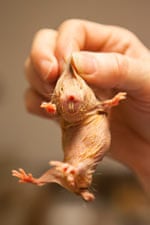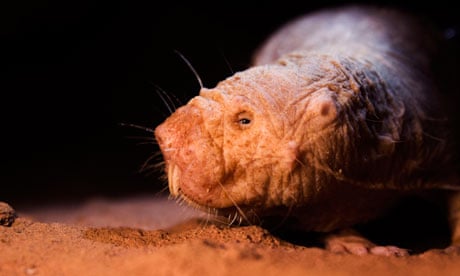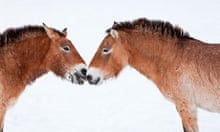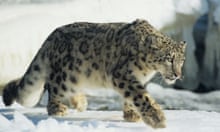Doctor Chris Faulkes, who has been working with them almost every day for the last 25 years, has long since learned to love naked mole rats, but, as he concedes, since they are "pretty much blind and live underground in the dark, they are not necessarily naturally selecting on good looks".
We are talking in Faulkes's lab at Queen Mary University in the East End of London, surrounded on all sides by his home-made rat-run of Perspex tubing in which 70 or so naked mole rats – each between 10cm and 20cm long – are scurrying, climbing over and under one another, backing up and beetling forward, worrying at anything in their path with their protruding incisors, teeth that they can move independently like chopsticks, all to apparently urgent purpose.
Faulkes argues for "a certain cuteness" in his research subjects (a quality that challenged even Disney in its animation Kim Possible), by pointing in particular to "their little twittering noises, with about 18 vocalisations that seem very important to them and which makes them sound a bit like baby birds". But though the naked mole rats do not immediately impress with grace and beauty, there are plenty of other characteristics in which they are almost preternaturally evolved; traits including extraordinary longevity and the apparent ability to avoid cancerous tumours, qualities that might yet make them man's best friend.
Naked mole rats – the name is bluntly accurate – are native to the drier plains of East Africa. Though they can live for more than 30 years, up to 20 times as long as comparable-sized rodents, they almost never emerge from below ground. A typical colony tunnel network might run to 4km in an area the size of a football pitch and the mole rats, which can run as fast backwards as they can forwards, will shift three or four tonnes of earth in the few weeks after it rains.
A naked mole rat was first documented by Eduard Rüppell, a German naturalist, in the 19th century, but he assumed from its unprepossessing appearance, the sagging nude flesh, the teeth growing straight through the skin, that it was a diseased or mutated individual of another species. It was not until the 1950s that the strange habits of this animal began to be known.
Jenny Jarvis, a researcher at the University of Nairobi, established a group in her lab, but could not understand why so few of them seemed to breed. This mystery was solved when advances in DNA studies proved that the naked mole rat was eusocial, which is to say colonies are organised like those of ants or termites – there is a single breeding queen, and two or three sexually active males, and the rest of the group, which can number up to 300, do not mate, but are deployed as workers – digging for the roots and tubers on which the colony feeds – or as soldiers, fighting off the occasional incursions of snakes into their tunnels.
It was this eusocial behaviour – currently considered to be unique among mammals to the naked mole rat and its close relative the Damaraland mole rat, though other social animals, including meerkats, practise a less regimented version – that first led Faulkes into a PhD on the animal. He had been working on odour research at Spillers cat food, trying to establish how smell influenced feeding, but when the chance came to return to academia at London Zoo, where the first British colony of naked mole rats had been established in 1987, he jumped at it.
"Time has gone pretty quickly since then," he says, with a laugh. "I suppose the first 10 years people were really focused on social behaviour, how the queen establishes precedence and suppresses the reproductive instinct of 99% of the colony. We wondered if it was done by smell, but it became clear she achieves precedence just by her behaviour rather than any pheromones or whatever." Faulkes was part of the team that wrote the naked mole rat genome and it was only after a lot of work had been done on relatedness, using genetic fingerprinting techniques and so on, that scientists "started looking at other weird aspects of their physiology".

The most striking of these to begin with was just how long naked mole rats lived. When researchers studied the rodents over a period of years in the lab, they began to notice how few of them ever died. Faulkes has some individuals from the original colony at London Zoo established from nearly 30 years ago. In American labs, there are naked mole rats still going strong – both forwards and backwards – at 32. Closer study revealed that not only did naked mole rats live a long time, they also resisted almost all typical signs of ageing. The queen and her chosen males could continue breeding without any apparently loss of fecundity. There was no menopause. Blood vessels remained in good condition throughout the naked mole rats' life, with negligible loss of elasticity.
One emphasis in Faulkes's work is into muscle conditioning – naked mole rats seem able to maintain near-perfect muscle structure into old age and are able to repair mitochondrial damage in cells, the kind of damage that is the causal factor in any number of human ailments, from senility to heart failure.
Some of these traits appeared to be linked to the particular series of adaptations that the animals had made to their extremely harsh underground environment – the ability to breathe in low oxygen/high CO2 atmospheres that would kill a human, as well as the evolved ability to suppress pain in their skin (acid burns do not make naked mole rats flinch) and, most extraordinarily perhaps, their cancer-free existence (again, apparently unique among mammals).
Last month, new research published in Nature by a group at Rochester University at New York gave an insight into how this tumour-resistant mechanism might work, research that promises, perhaps, to have a profound effect in a human context. Vera Gorbunova, who co-led that research, has been working on the question since 2005. She describes the work by phone as a different, other-end-of-the-telescope kind of approach to applied biology. "Generally, biologists have worked with mice or drosophila fruit flies to test theories because they are comparatively short-lived and have a quick reproductive cycle, which allows you to study effects on many generations," she says. "With this, we went at it in a different way. If you are studying longevity, for example, why not study animals that have evolved such genetic traits to enable them to live a long life and see how they might have done it?"
With her team, she identified the fact that cells of naked mole rats display a very high degree of proximity inhibition – they don't like to grow close together. This inhibition was proved to be the result of a complex sugar called hyaluronan (HMW-HA), which is present in all mammals, filling the gaps between cells, but which naked mole rats produce in abundance. The molecular structure of their HMW-HA is many times larger, and they are slower at recycling it, meaning that the hyaluronan "goo" builds up in a unique way, giving the naked mole rat the ability, among other things, as Faulkes says, of "almost turning a full somersault within its own skin".
The team at Rochester discovered that the presence of the "goo" enabled a gene identified in an earlier study to activate, causing cancer cells effectively to self-destruct and tumours never to form. The goo is a natural by-product of any attempt to grow naked mole rat cells in a Petri dish. Gorbunova suggests that the next step will be "to introduce this into mice, to see if it has the same effect, and the mice achieve greater age, as well as no cancer". After that, human trials may be possible, though there are no plans in place yet; the Nature article produced a great deal of interest but no extra funding.
Gorbunova is hopeful, however, that the introduction of HMW-HA will be possible into human cell structures and the usual laborious timescale of trials might be short circuited somewhat, not least because a very similar sugar molecule is already being used as an anti-inflammatory treatment for arthritis in people, and is also present in some cosmetics, suggesting it may be tolerated by the body.
However, while the body might tolerate one-off applications of HMW-HA, acting against cancer may require re-engineering of all the body's cells to express the molecule, an extremely ambitious and potentially hazardous project. Moreover, it may be that HMW-HA has a role in preventing cancer in mole rats but it's not the entire explanation. A lot of complex research needs to be done to determine whether this discovery could help treat cancer in humans.
Having studied the mole rats for a long time, Gorbunova, like Faulkes, has become somewhat obsessed with their outlier qualities. She suggests that their unique and generally peaceable social organisation may be one factor in their longevity. Not only does the suppression of reproductive urges help the colony to co-operate rather than compete, it also means that an individual might be called on to step up to mating duties at any time. "Potentially, any animal can become a breeder, so they may sit and wait for years for their chance to become productive," she says. "It would follow that it would be worthwhile for them to live very long in the hope that eventually their time will come."
Faulkes is examining that extraordinary capacity for patience in a comparative study with the Damaraland mole rat, a close cousin of the naked mole rat from southern Africa, animals that conversely display aggressively solitary behaviours, the males meeting the females only to mate. "Partly it seems to come down to the availability of food," Faulkes says. "For the naked mole rats, finding food is hard; the underground tubers on which they live are scattered far apart and an individual would struggle to find enough digging in the dark. A co-operative strategy, though, benefits the whole colony."
But, with South African colleagues, he also is studying the genetic component of this behaviour. Citing the noted study by Larry Young into voles, which went some way to proving their monogamy was a function of the way in which the hormone oxytocin was transmitted in the brain, Faulkes believes something similar will likely be revealed in the naked mole rats. The presence of oxytocin in the "pleasure centre" of the brain seems crucial to their ability to form harmonious groups (its lack seems equally significant for their antisocial South African relations).
In this kind of way, Faulkes says, "we are slowly learning more and more" about the compelling and unique creatures that are rattling endlessly round the tubes around us as we talk. More than a few stubborn mysteries remain, however, including the obvious one: "We have no real idea at all," Faulkes admits, "about why they might be naked."











Comments (…)
Sign in or create your Guardian account to join the discussion